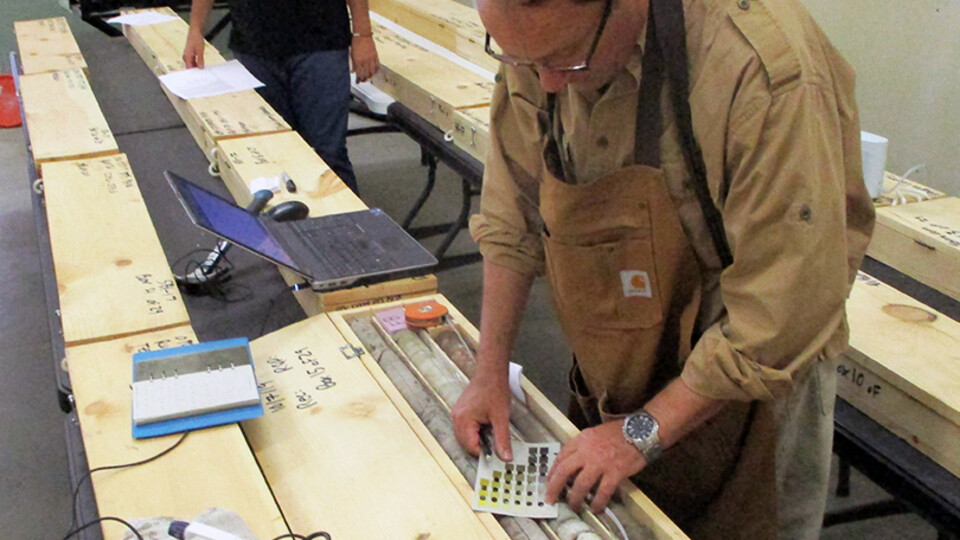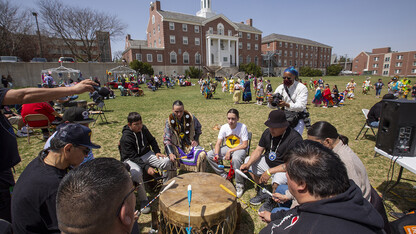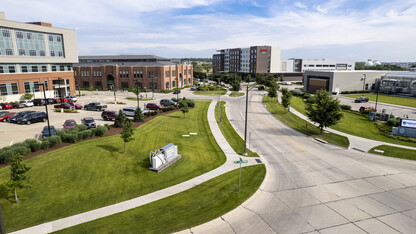· 4 min read
Joeckel contributes to Omaha bedrock tunnel project

About 12 years ago, Matt Joeckel learned from a colleague that something rare was about to happen in Omaha. The city was exploring the possibility of building a long bedrock tunnel that would allow stormwater and sewage to travel to a retention treatment basin.
The tunnel would be constructed in rock some 200 feet beneath the city. A dig that deep would require exploratory testing of rock cores located down to, and beneath, the tunnel’s proposed path. Joeckel, senior associate director for the University of Nebraska–Lincoln’s School of Natural Resources, quickly took interest.
“He said ‘cores,’ and I said, ‘What cores?’” Joeckel said. “It’s unusual to have deep bedrock cores drilled in eastern Nebraska.”
That interest helped lead to a partnership between the City of Omaha and the school’s conservation and survey division, in which Joeckel studied a total of 22 cores unearthed in 2008 and 2019 — all of which are being stored at a University of Nebraska–Lincoln facility in Mead.
“I saw it first as an opportunity to assist our urban clientele, and show that CSD and its geological expertise are valuable,” Joeckel said. “And second of all, I’d like to think that it helped out 400,000 people.”
Joeckel’s initial efforts took place in a non-air conditioned warehouse in downtown Lincoln, where he examined five test cores that were unearthed in 2008. About the diameter of a fluorescent tube light, the cores each measured between 200 and 250 feet in length. They were drilled from along the tunnel’s proposed path that runs parallel to the Missouri River. Joeckel’s job was to identify and name all the layers of bedrock found in each core and describe them in a detailed way that would be useful for the tunnel project engineers.
“That may not seem like that much effort, but it really is,” he said. “Layers of rock don’t come with names on them. And in the bedrock underneath Omaha, there are dozens of relatively thin layers of rock, each of which has its own name.”
After identifying the rock layers, Joeckel then sought to match them with the equivalent sequence of rock strata from adjacent states like Iowa, Kansas and Missouri. Some of these strata disappear from one area to another; others change thickness and characteristics markedly across the region.
Geologists have changed the names and hierarchical classification of the rock strata over time. Getting those dozens and dozens of names right, and putting them into the most up-to-date hierarchical scheme, allows engineers and other geologists who working on the same project to speak the same scientific language. Joeckel’s findings provided insights into bulk-rock physical properties and also helped officials and other project partners determine that the bedrock tunnel was, indeed, feasible.
Over a decade passed before Omaha officials reached out to Joeckel again. During the exploratory portion of the project, Joeckel examined the five cores in 2008 free of charge. In 2019, Joeckel was commissioned to provide layer analysis of an additional 17 cores for the full project.
“I was really pleased that they asked me to do that, and very pleased that some funding came into the CSD budget,” he said.
Joeckel’s efforts were lauded in a recent Clean Solutions of Omaha quarterly report, as well as a thank-you letter from City of Omaha Public Works project manager Jake Hansen.
“The information you provided was essential in correlating the core and developing the subsurface profiles needed to evaluate the tunnel alignment alternatives,” Hansen wrote. “The team cannot thank you and the Conservation Survey Division enough for all the support provided over the last year. We look forward to working with you again in the future.”
In analyzing the cores, Joeckel was able to take a rare glimpse into the region’s ancient geological history.
“Every time I opened a set of core boxes, I learned something new,” he said. “We would be going along and I would be seeing the same characteristics in the same layers, and then, in one or two cores out of 17, it would be different. It was really exciting. In one of the units I could see that the layers thickened, probably into what must have been an ancient estuary or river mouth. There were also a few examples of thin coals that we didn’t know existed in eastern Nebraska, but there they were. There were also abundant marine fossils in some of the strata. And when it wasn’t tedious, it was fun.”
In a future phase, more cores will be dug in an effort to determine the tunnel’s proper depth. Those cores, along with the 22 already bored, will be available for study thanks to the agreement between Omaha and the university.
“They will be a value for decades if not centuries,” Joeckel said. “Anytime you pull a core, it’s a new world.”







